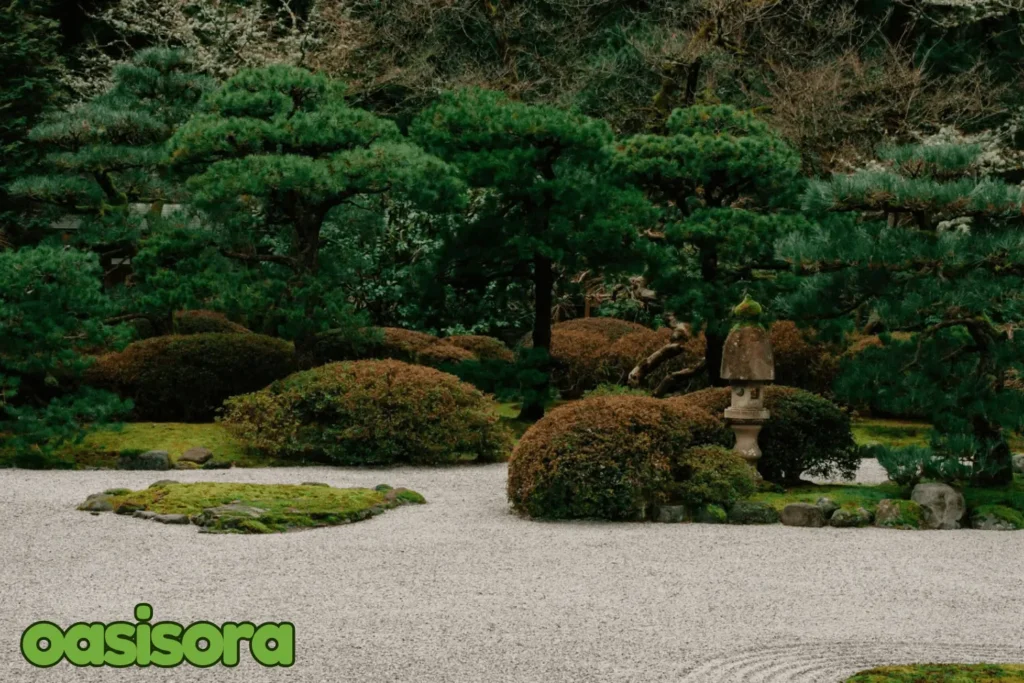
Among the busy lifestyle of modern times, a zen garden offers you peaceful safe spaces for rest and meditation.
These places require different zen garden ideas with representative items, such as raked gravel and rocks, to show the magnificence of nature rather than real images.
Every element, from the gently running river to the precisely arranged stones, contributes to an atmosphere of peace and harmony.
Several other factors impact the grace of Zen gardens, so prefer these seven basic principles to get a true design,
- Kanso – (Simplicity) : Preserve an organized environment.
- Fukinsei – (Asymmetry): Give up specific perfection.
- Shizen – (Naturalness ): Display the beauty of nature.
- Yugen – (Mystery): Include items that spark your interest.
- Datsuzoku – (Freedom ): Freedom from everyday practices.
- Seijaku – (Stillness): Set up a calm area for rest.
- Kokoro – (Heart): Put your desires and energy into the garden.
Let’s discuss optimal zen garden setups that bring calm and beauty to your living place.
Jump To
TL;DR
- Modern architectural designs may benefit from the traditional Zen ideas.
- Wood, sand, gravel, and rock are the core elements that compose Zen layouts.
- The minimalist zen garden planting comprises mosses, Japanese maples, groundcovers, and everlasting shrubs.
- Walls and screens around plants block all unwanted voices and noise to retain the calm atmosphere of Japanese gardens.
Perfect Zen Garden Ideas to Incorporate into Your Backyard
These 20 Zen garden arrangements vary from traditional designs to useful trendy adjustments.
The Japanese garden style covers all of them. Keep on reading for a calm feeling of relaxation.
1. Rock, Gravel, Sand
Classic Zen gardens, widely known as karesansui, are extremely dry, plain natural environments formed by rocks, gravel, and sand.
They focus on quality over quantity and just rely on a limited number of specially chosen plants.
For an artistic look, large trees and bushes are frequently combined with basic ground coverings.

Rock Gravel Sand in Zen garden
But what is a Karesansui’s distinctive feature?
Its Raked Gravel
The raked structures indicate flowing water, and open gravel areas look similar to ponds or lakes. Little outside spaces can utilize open gravel portions as pathways.
Prioritize raked gravel over sand as it gives the accurate form to your space.
2. Rock Sculptures and Arrangements
Do you know what is amazing about Japanese rock gardens?
Surely Rocks

Rock Sculptures Arrangements in Zen garden
Rocks symbolize mountains, islands, courage, and strength in traditional Zen gardens.
When mixed with extra symbolic parts, the outcome can be effective and significant.
For instance, extracted gravel, indicating a lake or sea, frequently covers a collection of three rocks, which suggests islands.
To create a focal point of Zen garden style rocks of different sizes should be gathered in odd numbers and set up in a triangle.
You can freely add your unique style, such as merging classic components with new trends like stone seating.
Look how beautifully outdoor space follows the basic principles of designing a minimalist garden with the latest stone settings.
3. The Moss Effect Enhances Zen Garden Ideas
Most Zen gardens comprise of mosses. This may be because these historic organic carpets have existed for a long time.
Presently, they are among the ancient living organisms dating back 450 million years.
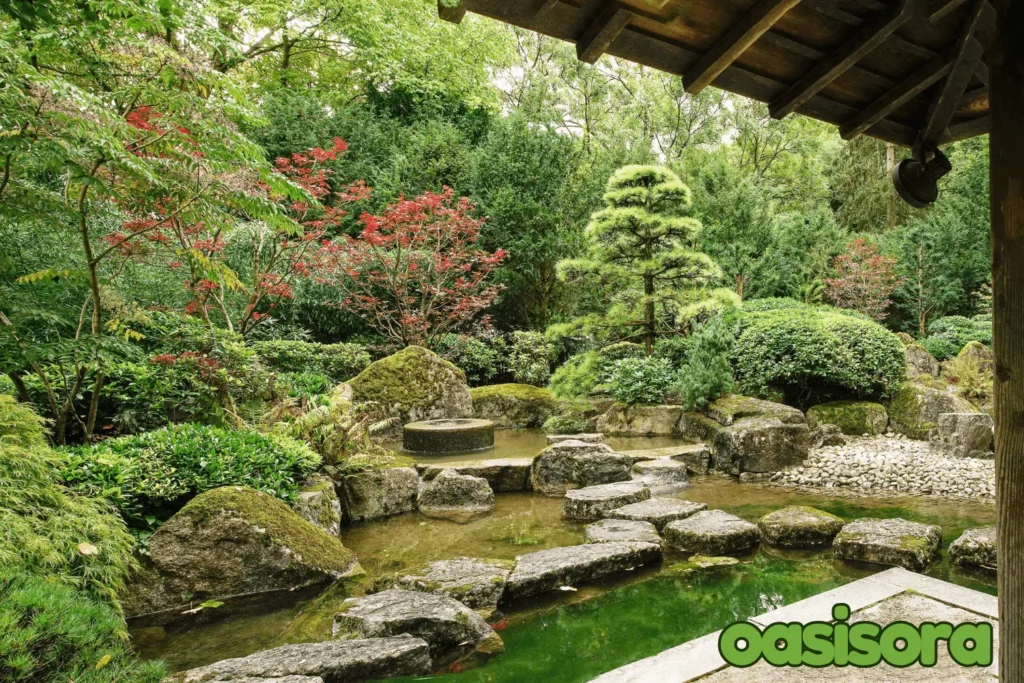
Blanket of Moss and rhododendrons at the Japanese Portland Garden
Moss has been highly valued in Japanese culture and often appears in poetry to symbolize the passing of time.
Shizen, or naturalness without artifice, is a central aspect of Zen design, and moss illustrates this idea.
These plants in landscapes attract attention to the elegance and simplicity of the natural world. The unique structure of moss is that it has no roots.
Rather, it has tiny hairy structures called rhizoids that help in its fixation.
These plants, that act as sponges as they soak up water from the air and rain. For your Zen garden, look into using moss replacements if you reside in a sunny, dry region.
Ground covers that grow quickly, such as phlox or sedum, are useful.
4. Screening the Outside World
Anything that distracts and loud noises may damage a Zen garden’s peace. Heavy scents, trash, and sounds of traffic spoil the overall experience.

Bamboo screen at the Portland Japanese Garden
Block out these outside disturbances to maintain the Zen environment. To protect the calm and secure the garden, you should use an upright screen.
Thick plants, stone walls, and wooden borders are all effective as well as vertical screens offer the best zen garden ideas to avoid noise.
Living screens are fantastic since they are affordable, attractive, and sustainable.
Bamboo screens were commonly used in ancient Japan. Consider native grasses, trees, vines, or shrubs instead of bamboo if it is not available in your region.
5. Symbolic Trees
Did you ever speak with a tree?
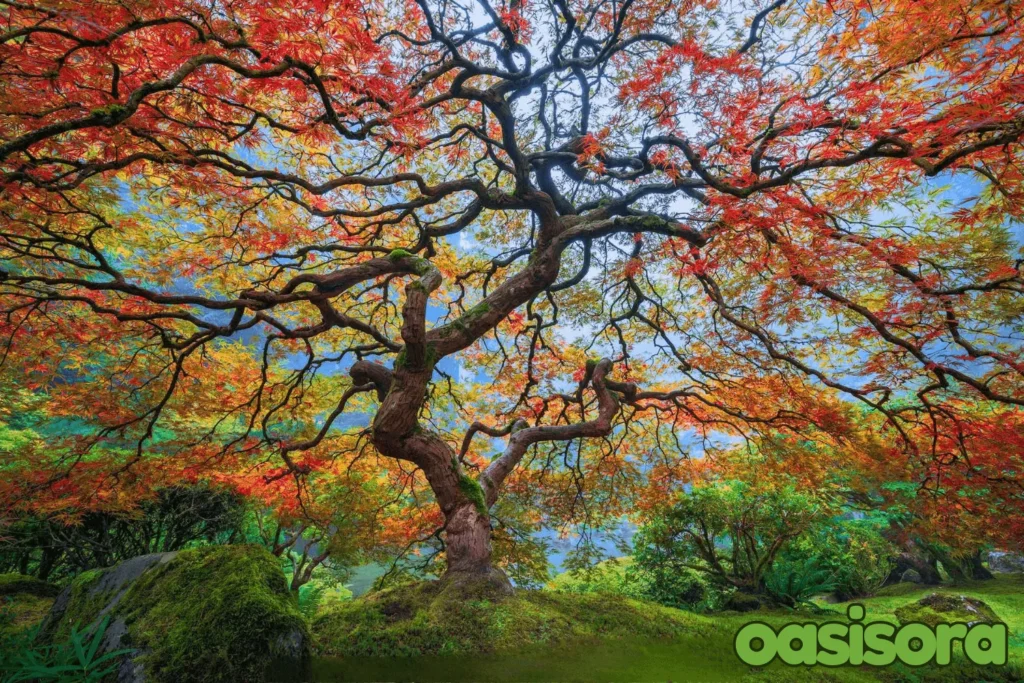
Moss on an on old Japanese maple at Portland Japanese Garden
The concept that trees are spiritual, living creatures is vital to the human experience, no matter how odd it may look.
Zen gardens are the same. As plants for the zen garden are selected carefully it is hard to underestimate the literal significance of trees as they are the garden’s main components.
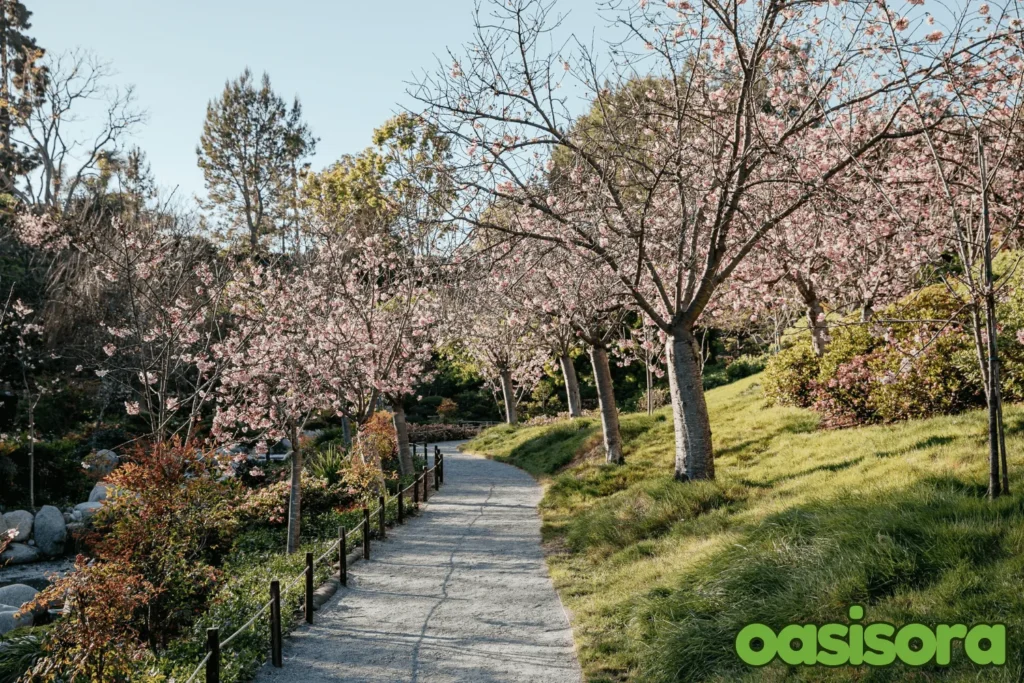
Cherry tree
Such places mostly possess pine, Japanese maple, cherry, plum, and peach trees.
Maintenance of Zen garden trees makes their character whereas shape enhances the beauty of your space.
Consider topiaries, tiny conifers, and bonsai trees as they are typical forms of trimmed Zen garden trees. For more information about Japanese plants visit our post 25 Japanese Plants for Your Garden.
6. Asymmetrical Paving Transitions
Zen garden design is gradually improved by asymmetrical flooring. It generates a sense of wonder and embraces the naturalistic approach of the zen landscape.
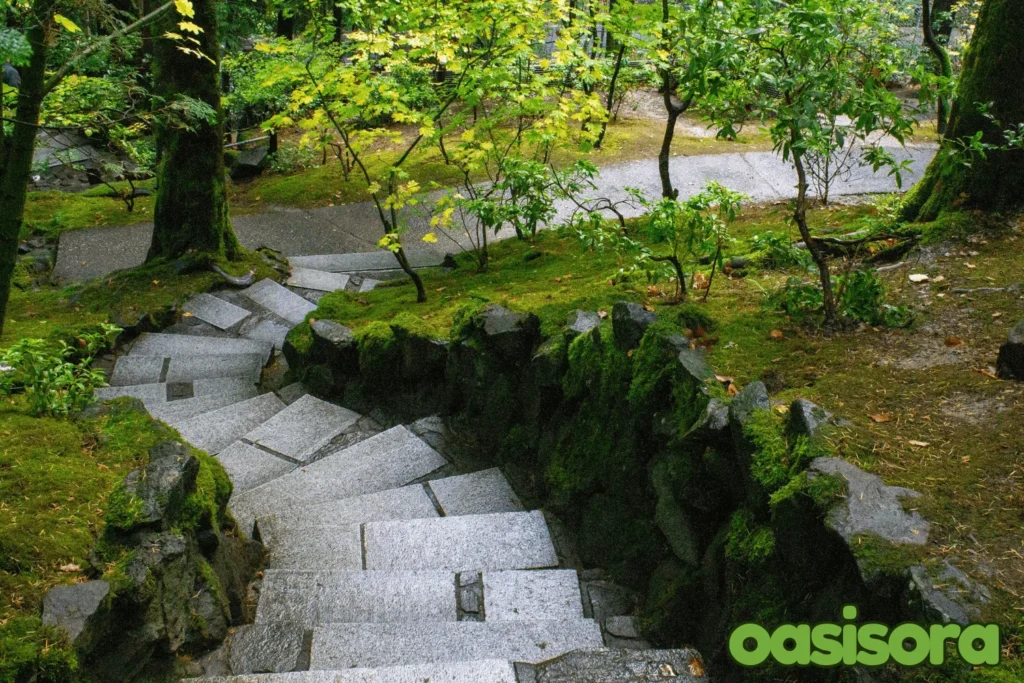
Mixed stone pathway at Portland Japanese Garden
7. Raised Wood Decking
High wood flooring offers you warmth and an area for relaxed thinking, meditative practices, and devotion inside a Japanese-style garden.
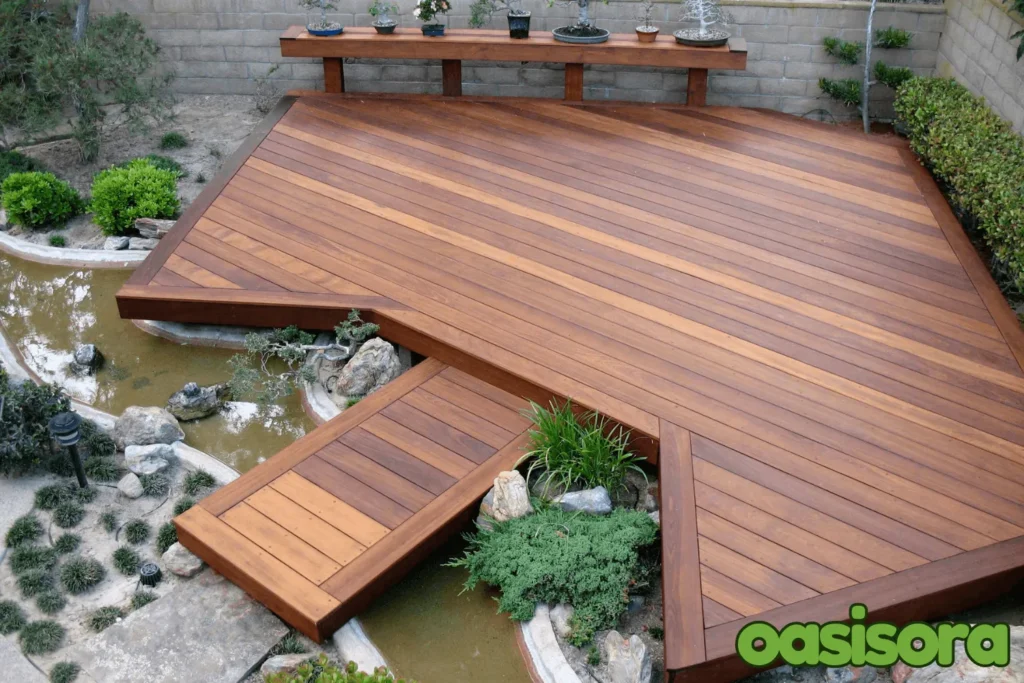
Wood Decking
8. Lantern Lighting
The magical atmosphere of traditional gardens originated from the use of beautiful stone and metallic oil lamps for nighttime lighting. According to advanced Zen garden ideas, stone lights are still prominent.
While keeping the garden’s enigma, gentle, indirect LED lights act as a less dangerous, fire-free solution.
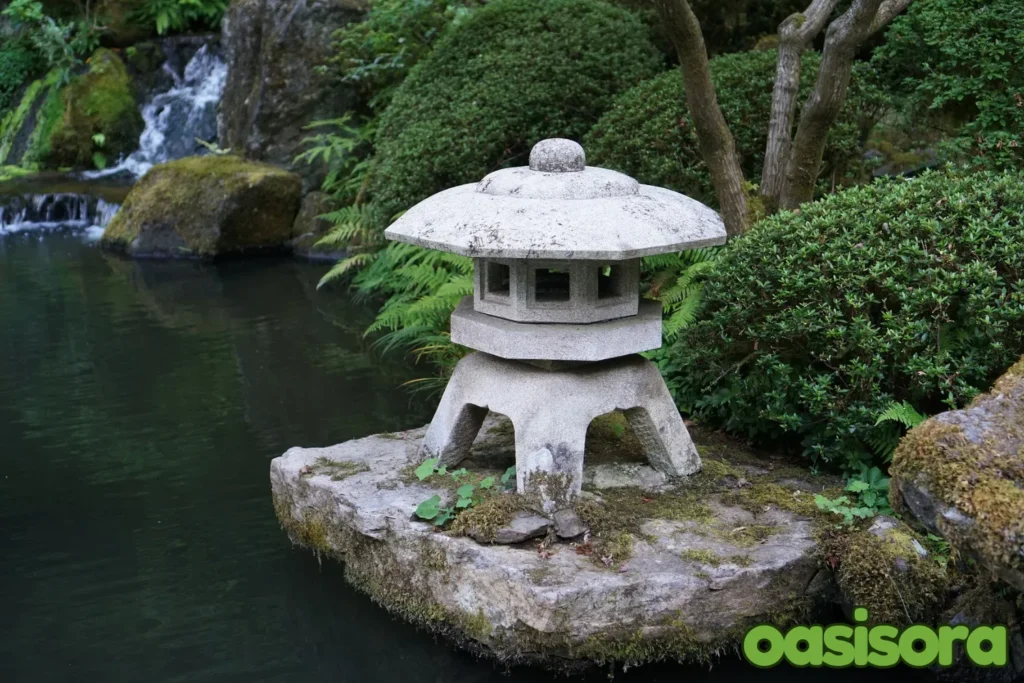
Lantern
9. Water Features for Soothing Sounds
Whatever the size, your outdoor water features involve an enormous amount of care.
A lot of famous Zen gardens make efficient use of running water to enhance the aesthetics of their outdoor spaces.
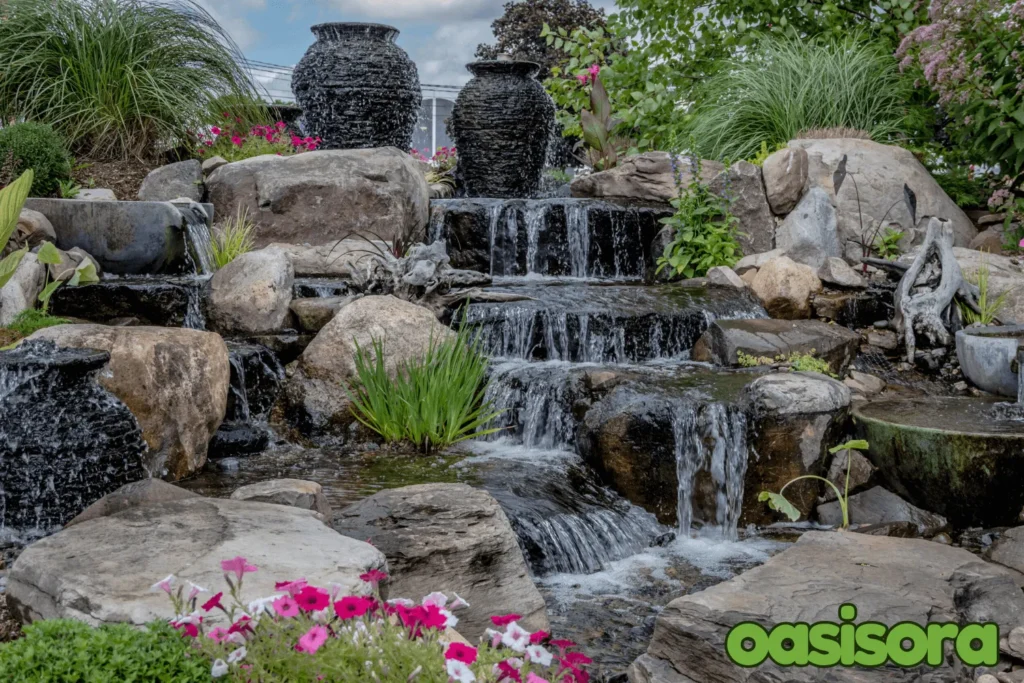
Water feature at the Japanese Friendship Garden Balboa Park
As you know, water is a sign of change, movement, and the continual evolution of life in the Japanese design of gardens.
A peaceful setting can be formed by using flowing water effectively drowning out excessive sounds in the city.
Use decorative elements that capture rainfall runoff to produce a similar peaceful sensation while saving money and reducing maintenance.
10. Incorporate a Bamboo Water Feature
An exclusive fountain of bamboo is a common water feature observed in Japanese gardens to increase their grace. The soft sound of flowing water creates a relaxing atmosphere that eliminates the outside noise of your calm atmosphere.
Traditional Zen design is perfectly enhanced by the natural, elegant aesthetic that tipping bamboo brings. Additionally, it establishes a calming pattern that promotes meditation and consciousness in your outdoor area.

Bamboo fountain
11. Decorate with a Buddha Sculpture
To create an interesting focal point in your yard, consider using a garden decoration, such as a standing figure or sculpture. Since Zen spaces initially developed in Buddhist monasteries, it is certainly appropriate to have a Buddha statue in your area. In addition to representing a spiritual awakening symbol, it also serves as a reminder to step back from your ego and view things more clearly.

Buddha sculpture
12. Koi Pond
Koi fish are a frequently occurring part of current Zen gardens.
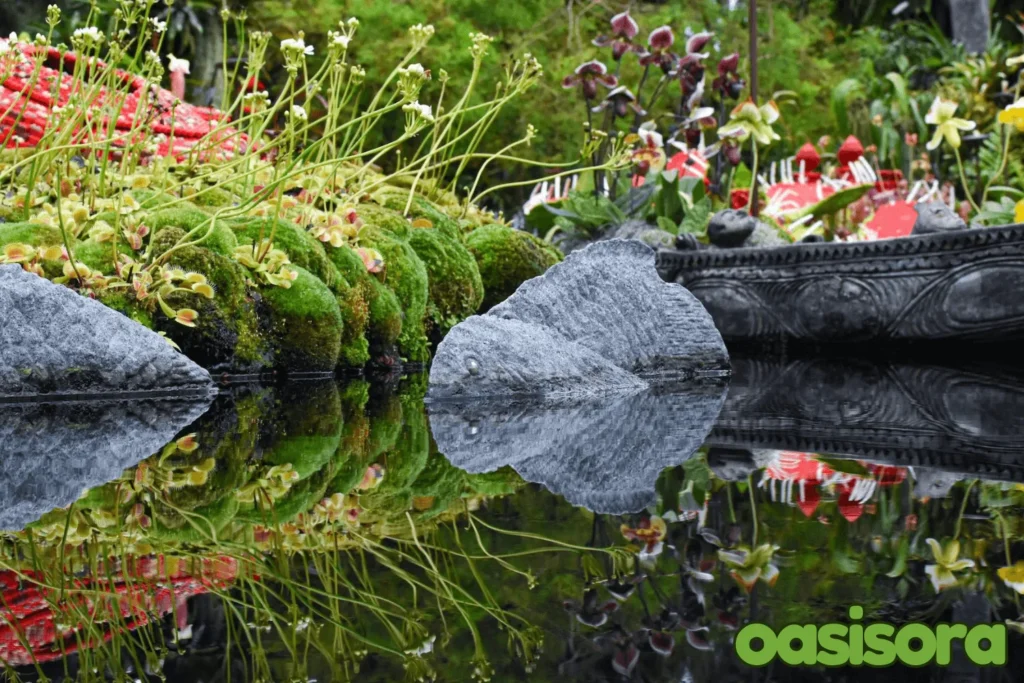
Koi-Pond
In the early 1800s, it was first commercially introduced in Niigata, a city in Japan. Nowadays, koi have become a popular industry generating heavy revenue all over the world.
Although rare kinds may sell for significantly greater prices, koi typically range between $15 to $100.
A premium Koi fish sold for about $2 million in 2018.
I suggest you invest in the water area by adding decks, stones, and bridges instead of buying expensive fish.
13. Seasonal Interest Garden
Zen gardens concentrate on just a few important plants that are skillfully cultivated. Select evergreen plants to maintain the garden’s charm all over the year.
As in the above image, trimmed trees and groomed shrubs, such as the Japanese maple, add interest to an area even in the winter.

Seasonal Colors in Zen garden
14. Plant a Bamboo Privacy Fence
Bamboos have deep significance in Japanese art, crafts, and architecture, allowing them to be an excellent choice for fences and as screens set in Zen landscapes. It is an excellent choice for any peaceful garden.
Available in different price ranges from simple rolls that are often utilized as screens in front of rough fences or for wrapping up trash bins, to more stylish fences and bamboo gazebos.
A reasonable privacy fence that efficiently hinders an unpleasant outside environment and nosy neighbors is generated by the sound of bamboo rustling.
It is relatively easy to care for, permitting you to enjoy more rather than spending time on pruning.
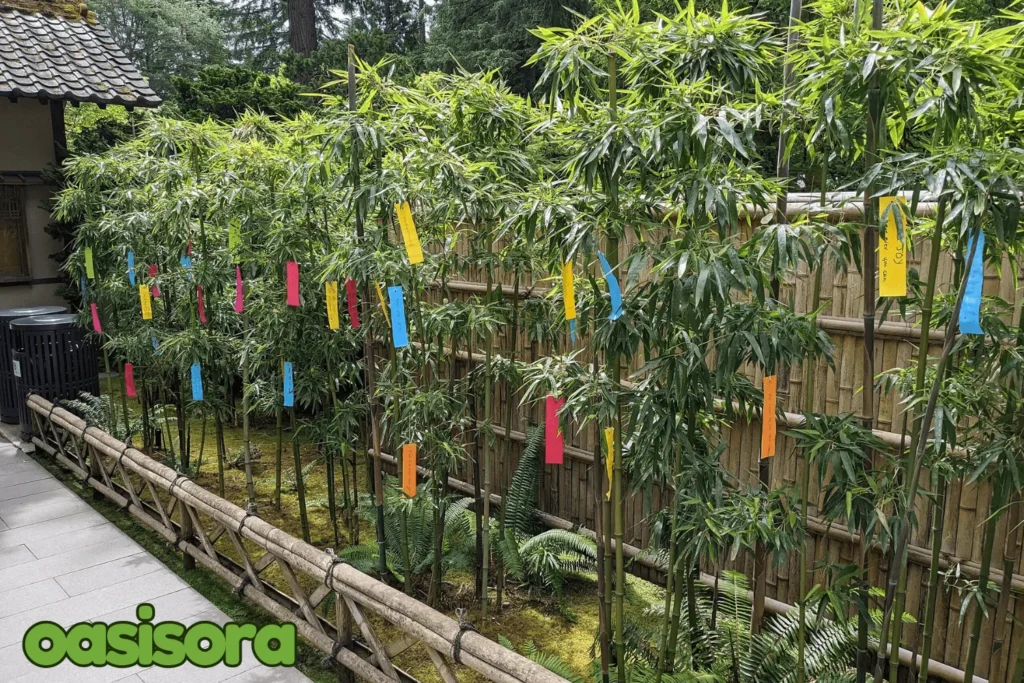
Bambo privacy fence
15. Create a Focal Point
A Zen garden’s distinct gateway functions as both a focal point and an interface to the external world. Try using circular and square shapes in the focal design to create something different. A central item, like a statue or sculpture that catches the attention, is frequently found in Japanese gardens.
Be simple while collecting decoration items for your zen garden. Modest and uncomplicated items are good to choose because the Japanese design depends mainly on minimalism.
Additionally, look into the landscape’s overall layout and the numerous ways in which multiple elements will work together when choosing where to put your attractive ornamental items.

Boulder as a focal point
16. Incorporate Moss
Its silky smooth and sensitive texture encourages you to stop down and feel the moss. One of the key aspects of the peaceful state that arises from spending time in a Japanese garden is the philosophy of taking your time to engage with nature and be aware of your senses.
Moss has central significance in Zen gardening. It flourishes well in Japan’s damp, wet climate and is commonly used for connecting spaces and creating a peaceful green backdrop. Though some mosses can tolerate more sunlight, but mostly varieties prefer shade with damp, mildly acidic, low-nutrient soils.
Stop attempting to raise mosses in unfavorable conditions and look for regions where moss currently grows.

Moss
17. Zen Garden Corners
A stunning Zen garden does not require so big ground as courtyards and balconies are equally efficient.
The Zen garden in the picture highlights how simple arrangements using natural products like stone, wood, and just one plant can result in an impressive focal point.
For more guidance regarding designing Zen gardens in small areas, see our blog post on “5 Zen Garden Ideas for Small Spaces.”
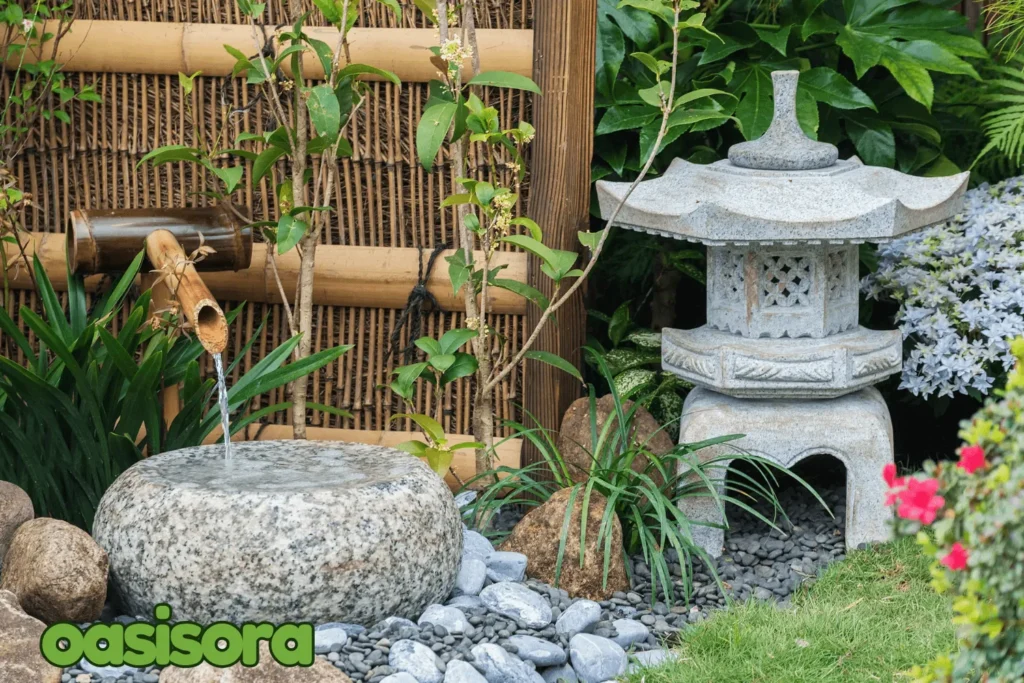
Zen Garden Corners
18. Meditation Space
Although meditation can be difficult, but can be highly beneficial to mental health. To promote inner calmness, opt for a specific area in your Zen garden for relaxation.
A plain deck or leveled space will be sufficient. Set it to take the greatest views of the garden.
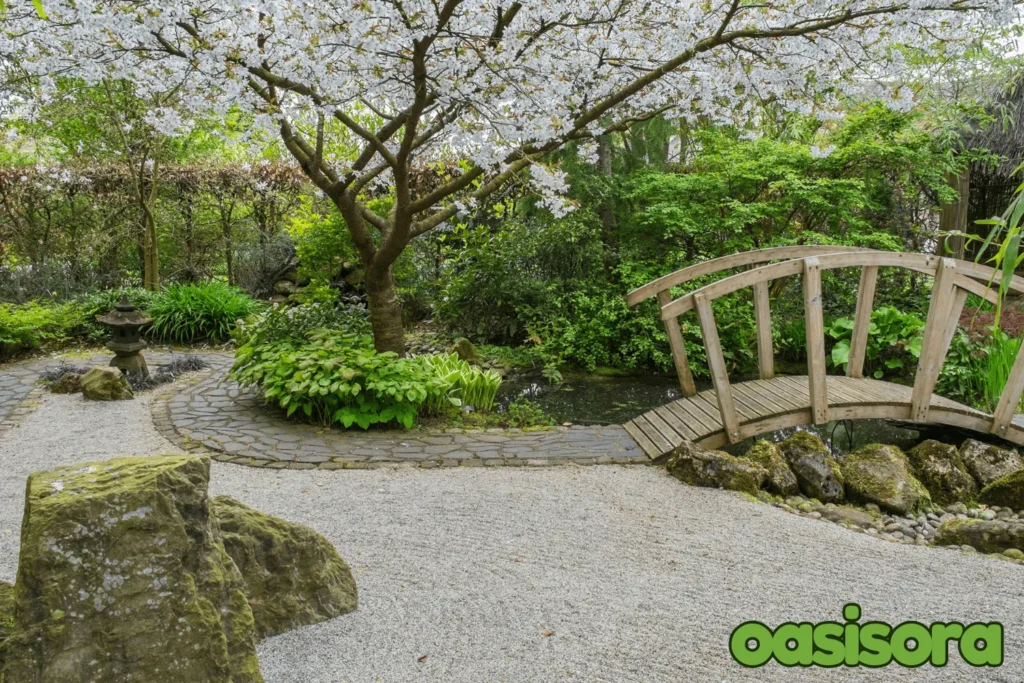
Meditation Space in Zen garden
19. Bridges
Bridges engage with Zen ideas of advancement and change because they indicate the journey from one particular state to another.
So they are fairly common throughout Japanese gardens.
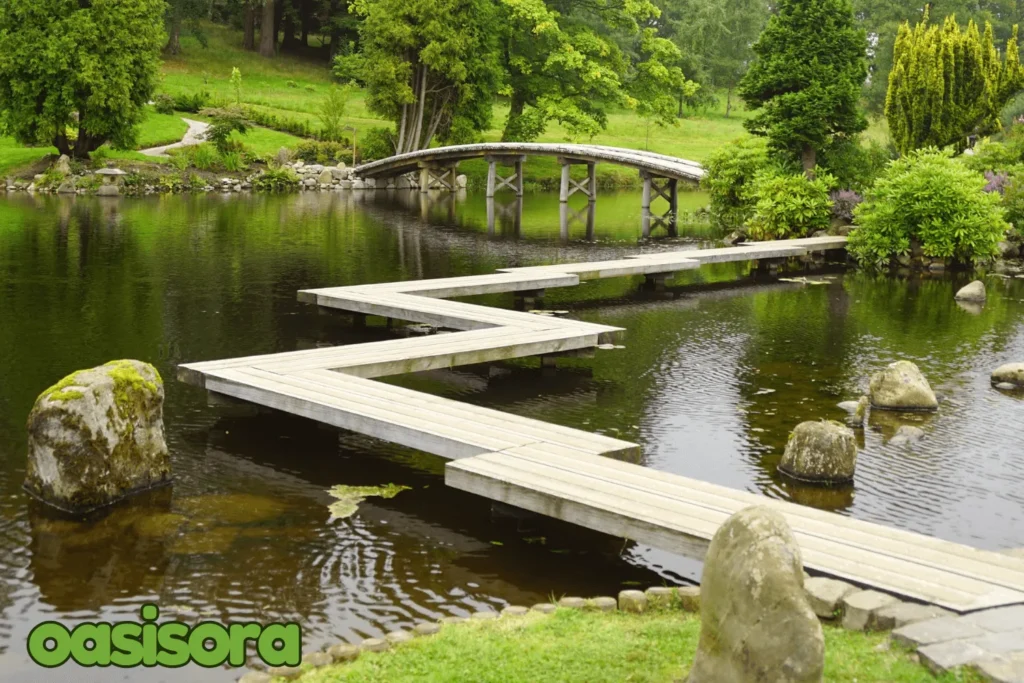
Bridges in Zen garden
20. Zen Garden with a Fire Pit
Historic Zen gardens are calm and fixed, so they are fire-free. Fire pits are a vibrant unique feature present in trendy gardens. It’s essential to use all components when there isn’t sufficient outdoor space.
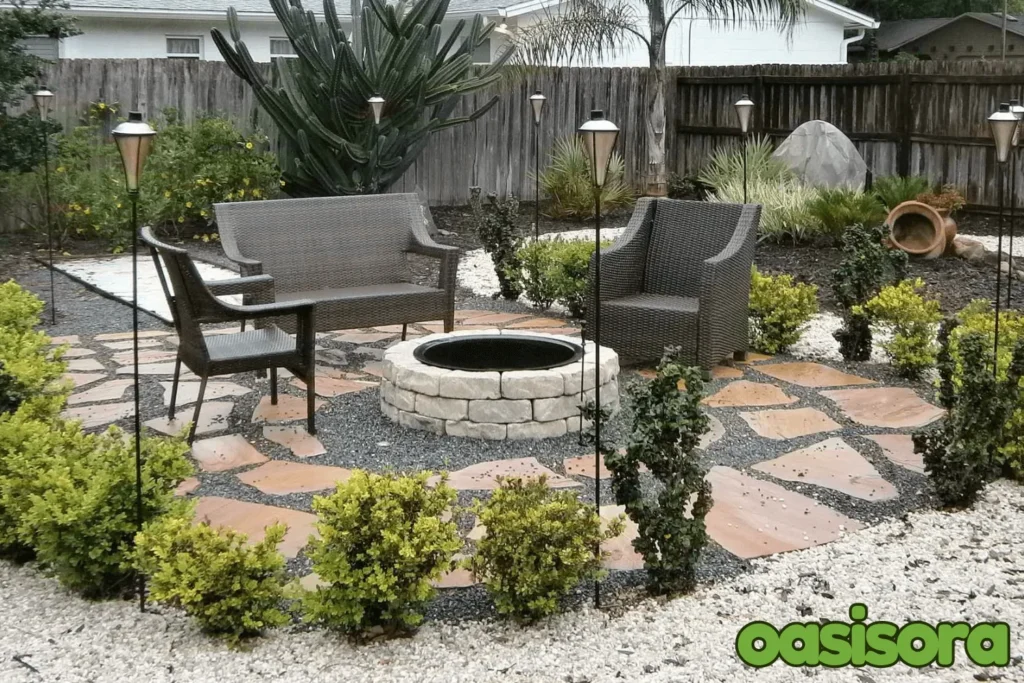
Zen Garden with a Fire Pit
History of the Zen Garden
Heian Period Origins (794-1185 AD): During The Heian period zen gardens initially appeared in Japan.”Shinden-zukuri” gardens were developed by royalty for beauty and entertainment.
These gardens then further formed the basis for the spiritual zen gardens.
Introduction of Zen Buddhism: In the 12th century, Zen Buddhism emphasized meditation and discovering beauty during his journey from China to Japan.
Artists and monks began creating gardens that expressed these ideas.
The Muromachi Period (1336-1573 AD): The current concept of Zen gardens was formed in the Muromachi era. Simpler, austere patterns replaced the complex Shinden styles in garden design.
The ideology of Zen had an important impact on these advancements.
Role of Zen Monasteries: The rise of peaceful Japanese gardens as areas for observation and meditation received significant assistance from Zen monasteries.
To promote meditation, seek simple zen garden ideas to capture the essence of nature. Sand, gravel, and rocks were put together in dry landscape gardens to portray seas, islands, and mountains.
Western Influence: In the 20th century, Zen spaces began influencing garden design in the West. Today’s supporters noticed their elegance and harmony. Over time, the value of the spiritual and moral structures declined.
Zen Gardens and Modern Mental Health: Zen gardens have returned to their spiritual significance as an outcome of recent scientific studies that underline the importance of mental wellness.
Maintenance and Care
Maintenance is necessary to preserve the peace and appeal of a Zen garden. These are a few basic tasks to handle the harmony of your quiet landscapes.
- Raking the gravel or sand.
- Plant care, such as watering, weeding, and shaping.
- Keeping boundaries and sidewalks unaffected.
- Managing the pond.
Rake the Sand or Gravel
Along with having a peaceful appearance that suggests waves rippling across water, raking sand helps to encourage calm and tranquility. Whether large or small, it is a quick and affordable method to add Zen garden elements and enhance the beauty of any area. Besides having a cultural significance, raked gravel is an important aesthetic feature of Japanese gardens.
The narrow rays of the sun in the morning and evening bring attention to the structures and texture of the gravel, producing an exciting and visually engaging landscape. Usage of these small pebbles is an easy-to-handle and more strong method than sand.
Tiny gravel or small, smooth pebbles are easy to organize into different forms and outlines. Its most prominent light-neutral tones are white, cream, or grey.
Remove Debris
Keep your yard clear of garbage such as weeds, twigs, and leaf litter. Particularly if there are nearby trees or other plant life, this junk can amass quickly. Regular disposal of waste may assist you in maintaining your garden’s tidy, basic appearance, which is an essential feature of traditional Japanese garden design.
Care for Moss
Maintain humidity in your outdoor garden if you’ve included moss. Because these plants like moist, shaded environments, gently sprinkle water when it’s dry. If it stays open to direct sunlight for a prolonged period, it can start to dry up and lose its lush, green appearance.
Trim Plants and Trees
Sometimes, periodic cutting becomes necessary for the growth of some species, like planting bamboo, mini trees of bonsai, or Japanese maple in their Zen-based garden. For the sake of keeping the outdoors looking neat and organized, prune any overgrown branches. Make sure the bamboo fits inside the specified limits.
Weed Control
No doubt, it’s easy to look after Zen areas, but wild plants like weeds continuously grow between the gaps of gravel and pebbles. It’s essential and easy to pull them by hand frequently to preserve the garden’s elegance and neatness. To stop weeds from spreading, spread a mulch layer or landscaping fabric under gravel.
Refresh Stones and Gravel
Organizing a serene atmosphere of a Zen garden involves reliably raking and maintaining gravel at regular intervals. Updating the garden’s orderly and peaceful appearance involves replacing all damaged gravel or stones.
Weather conditions like wind and rain can cause materials to undergo modifications over time, so frequent adjustments are necessary. Your yard’s quiet energy and aesthetic harmony are maintained through this straightforward management.
Maintain Water Features
Make sure your space stays clean and debris-free if it has a water element, like a running fountain or tiny pond. To preserve the water pump functioning properly and stop algae from developing, you may need to disinfect it and clear all floating junk regularly. Avoid throwing unnecessary things into your lovely water components to keep them sound, alive, and fresh.
Final Words
Setting up a Zen garden in your backyard gives an environment of peace for practicing concentration and relaxation.
With these trendy zen garden ideas you can make an area that encourages peace by including elements like raked gravel, water-based attractions, and basic plants.
A Zen garden’s beauty exists in its symmetry and simplicity, which inspire mental clarity and a connection to nature.
These tranquil outdoor areas provide a chance for peaceful thought and well-being, irrespective of the size of the region.
To convert your backyard into a quiet place that improves its appearance and peace of mind it’s better to use natural elements while keeping things modest.
FAQs
What are the 7 core principles of a Zen garden?
The seven core values are austerity (Shibumi), break from routine (Datsuzoku), naturalness (Shizen), asymmetry (Fukinsei), subtle (Yugen), minimalism (Kanso), and harmony (Seijaku).
How do I make my garden Zen?
Using various zen garden ideas like vegetation, gravel, stones, and features such as waterfalls creates a peaceful, simplified area focusing on natural factors, balance, and purity.
What is the idea behind a Zen garden?
Zen gardens, serving as a place for meditative practices self-awareness, and observation while expressing relaxation and change, preserve the true spirit of nature.
What are the eight elements of a Zen garden?
The eight components are rocks, gravel or sand, water, trees and shrubs, mosses, bridges, lanterns, and space all interact to create a harmonious environment.

12 thoughts on “20 Zen Garden Ideas for a Modern and Peaceful Space in 2025”